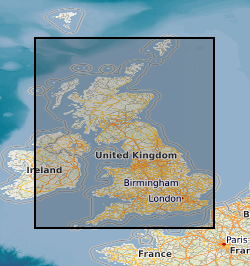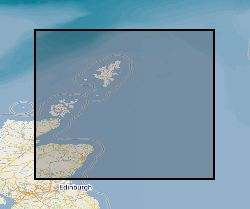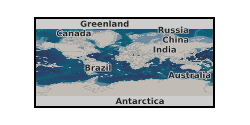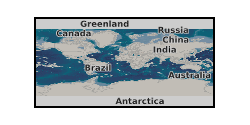Cretaceous
Type of resources
Topics
Keywords
Contact for the resource
Provided by
Years
Formats
Representation types
Update frequencies
Scale
-

Neodymium (Nd) isotope data measured from fossil fish debris and sediment leaches collected from IODP Sites U1512, U1513, U1514 and U1516.
-

Cretaceous to Recent marine assemblages (total of 24,372) used to measure uplift, interpreted paleo-water depths and measured uplift. This inventory contains information about age, location, stratigraphic origin (i.e., formation, unit, member), lithology, paleoenvironment, and tectonic setting at the time of deposition and references to original source material. An extended methodology is presented in, Victoria M. Fernandes, Gareth G. Roberts; Cretaceous to Recent net continental uplift from paleobiological data: Insights into sub-plate support. GSA Bulletin 2020;; 133 (5-6): 1217–1236. doi: https://doi.org/10.1130/B35739.1 Examples of this information being used to test mantle convection simulations is presented in, Victoria, M. Fernandes, Gareth G. Roberts, Fred Richards; Testing Mantle Convection Simulations With Paleobiology and Other Stratigraphic Observations: Examples From Western North America. G-Cubed 2024; 25(e2023GC011381). doi: https://doi.org/10.1029/2023GC011381
-

Three volumes of SAM samples (SAM1-SAM4789) exist. They represent the work of FW Anderson in the 1950s and 1960s. All samples were re-registered into other datasets. They are predominantly from the Cretaceous and Tertiary. Sample number, fossil type, locality and geological details are given, including borehole name and depth where appropriate.
-

This dataset shows the distribution of Middle Jurassic, Upper Jurassic and Lower Cretaceous lithostratigraphic (UK Offshore Operators Association - UKOOA) units within the UK North Sea graben. The data are based on a subset of released exploration and appraisal wells from within the UK North Sea graben areas. The well data are concentrated in the areas overlying the deep sedimentary basins of the Viking Graben, Central Graben and the Moray Firth Basin, with fewer wells over the adjacent platforms. The UKOOA lithostratigraphic classification has been applied consistently.
-

Stable Isotope and trace element analyses (Ca, Sr, Mg, Fe and Mn concentrations) derived from Cretaceous Belemnites including Duvalia tornajoensis, D. cf. lata constricta, D. binervia, D. cf. emericii, Hibolithes, H. cf. jaculoides, Berriasibelus, Castellanibelus and Pseudobelus.
-

Cretaceous-Paleocene calcareous nannofossils from Site U1579 drilled on the Agulhas Plateau, Southwest Indian Ocean during International Ocean Discovery Program Expedition 392 Agulhas Plateau Cretaceous Climate in February-April 2022. The submitted files include data on Cretaceous-Paleogene (K-Pg) boundary calcareous nannofossil biostratigraphy and range chart, percentage assemblage counts and bulk carbon and oxygen isotopes from K-Pg sediment samples.
-

Registers of microfossil analyses carried out by FW Anderson in London mainly during the 1950s and 1960s, but includes older collections,notably those of Davis (1935) and Burrows (1948). Specimens recorded are mainly ostracods, but include some foraminifera and some charophytes and holothurians. Sample number, locality/borehole, specimen identifications, remarks, cross referencing to the SAM and other data sets are given. The set is arranged: MIK(M) 1-4483 in 41 volumes on Mesozoic (predominantly) ostracods MIK(T) 1-1590 in 11 volumes, Tertiary foraminifera MIK( C) 1-400 in 5 volumes, Carboniferous ostracods MIK (J) 1-1219 in 8 volumes Jurassic microfossils (few identifications) MIK(K) 1-677 in 7 volumes Cretaceous microfossils (identifications patchy) MIK(J)F, MIK(K)F and MIK(T)F are small foreign collections.
-

Trace element and isotope data measured on 36 sediments that record the opening of the south Atlantic preserved onshore, Brazil. The samples come from two main pre-salt sections within the Araripe Basin close to Juazeiro do Norte, Ceará State: the Três Irmãos quarry which records a lacustrine succession and the younger Sobradinho River Section which is a sequence of organic-rich, ostracod-bearing mudstones. Additional gypsum and ostracod samples, procured from two quarries within the Araripe Basin, were analysed to provide data from the main salt-forming interval. The samples were collected during 2023 by a team from Bristol University (Ian Parkinson, Rachel Flecker), Sao Paolo State University (Rafaela Cardoso Dantas) and University of Utrecht (Dan Palcu). The samples were analysed at Bristol University 2023-24 as part of the PhD project of Rafaela Cardoso Dantas. The aim was to use the Sr isotope and Os isotope data to reconstruct the connectivity between the global ocean and opening South Atlantic. Trace element, carbon and nitrogen analysis were analysed to help reconstruct the environmental conditions in the basin.
-

The dataset consists of eleven spreadsheet tabs, each tab containing lipid biomarker palaeothermometry (air temperature reconstructions) and bulk organic carbon isotope data from individual lignites that are known to stratigraphically span the Cretaceous-Palaeogene (K-Pg) boundary. Uncalibrated, raw biomarker distributions (glycerol dialkyl glycerol tetraethers; GDGTs) are provided, as well as the calculated calibration outputs. Site coordinates are: West Bijou, Colorado (39°34'14'N, 104°18'09'W), Sussex, Wyoming (43°39'40"N, 106°19'06"W), Pyramid Butte, North Dakota (46°25'03'N, 103°58'33'W), Hell Creek Road, Montana (47°31'35"N, 106°56'23"W), Rock Creek West, Saskatchewan (49°02'20"N, 106°34'00"W), Wood Mountain Creek, Saskatchewan (49°25'20"N, 106°19'50"W), Frenchman Valley, Saskatchewan (49°20’56"N, 108°25’05"W), Knudesn’s Coulee, Alberta (51°54’27"N, 113°02’57"W) Griffith’s Farm, Alberta (51°54’47"N, 112°57’51"W), Coal Valley Cores (GSC CV-42-2, Cores 1 and 2), Alberta (53°05’02"N, 116°47’ 40"W) Police Island, Northwest Territories (64°52'42"N, 125°12'33"W).
 NERC Data Catalogue Service
NERC Data Catalogue Service